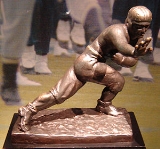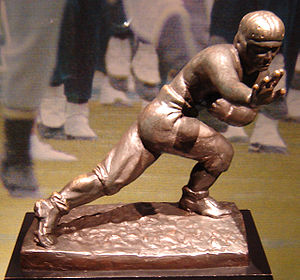
Stiff-arm fend
Encyclopedia

Football
Football may refer to one of a number of team sports which all involve, to varying degrees, kicking a ball with the foot to score a goal. The most popular of these sports worldwide is association football, more commonly known as just "football" or "soccer"...
.
The skill
In rugby leagueRugby league
Rugby league football, usually called rugby league, is a full contact sport played by two teams of thirteen players on a rectangular grass field. One of the two codes of rugby football, it originated in England in 1895 by a split from Rugby Football Union over paying players...
, rugby union
Rugby union
Rugby union, often simply referred to as rugby, is a full contact team sport which originated in England in the early 19th century. One of the two codes of rugby football, it is based on running with the ball in hand...
, American football
American football
American football is a sport played between two teams of eleven with the objective of scoring points by advancing the ball into the opposing team's end zone. Known in the United States simply as football, it may also be referred to informally as gridiron football. The ball can be advanced by...
and Australian football, ball-carriers run towards defenders who are attempting to tackle them. By positioning the ball securely in one arm, the ball-carrier can fully extend his other arm, locking his elbow, and outstretching his palm. Then, the ball-carrier pushes directly outwards with the palm of his hand onto the chest or shoulder of the would-be tackler. The fend is a pushing action, rather than a striking action.
A stiff-arm fend may cause the tackler to fall to the ground, taking him out of the play. Even if the tackler keeps his feet, it becomes impossible for him to complete a tackle, as he cannot come close enough to wrap his arms around the ball-carrier.
A well-executed stiff-arm fend can be a very powerful offensive weapon. In Australian football, it can allow a player to break free from an imminent pack, often completely changing the direction of play. In rugby and American football, the stiff-arm fend can be effectively used to fend off pursuing defenders, or to create holes in a defensive line to the front. This is particularly important in rugby, where American football
American football
American football is a sport played between two teams of eleven with the objective of scoring points by advancing the ball into the opposing team's end zone. Known in the United States simply as football, it may also be referred to informally as gridiron football. The ball can be advanced by...
-style blocking
Blocking (American football)
In American football, blocking is a legal move occurring when one player obstructs another player's path with his body. The purpose of blocking is to prevent defensive players tackling the ball carrier, or to protect the quarterback while attempting to pass or hand-off the ball...
is not permitted, making a stiff-arm fend the only legal way to physically create a hole in the defense.
The term don't argue was coined in Australia to describe the stiff-arm fend. The term describes what a commentator imagined the ball-carrier might be saying as he shoved his opponent in the face or chest, and is used as a noun.
Ball-carriers in Australian football must be careful to avoid fending opponents in the head or neck, otherwise they will concede a high tackle free kick. High fends will generally be allowed in rugby unless the referee rules that the fend is too forceful, constituting a strike rather than a push. In Rugby, as stiff-arm tackle (ie: locked elbow and extended arm prior to making contact with the defender) is dangerous play. A player makes a stiff arm tackle when using a stiff-arm to strike an opponent (Laws of the Game, Rugby Union, Law 10.4, dangerous Play and Misconduct, Section (e), dangerous tackling). Therefore, a stiff-arm fend, as described above is permitted (even a high fend) so long as it does not constitute striking the opponent (similar to an open handed punch).
Physics
The stiff-arm fend is particularly effective because its force is applied down the length of a straight arm, directly into the shoulder. This puts the arm bones exclusively under compressive axial stress, the stress to which bone is strongest, and ensures that minimal torque is applied to the shoulder joint. As such, the force that can be applied by a stiff-arm fend can easily repel or topple an oncoming defender. The same techniques are practised by some schools of martial artistsMartial arts
Martial arts are extensive systems of codified practices and traditions of combat, practiced for a variety of reasons, including self-defense, competition, physical health and fitness, as well as mental and spiritual development....
when striking or punching; by ensuring that the direction of the force is directly down a locked, straight arm, martial artists can punch through bricks and tiles without damaging their arms.
External links
- Classic Sports Moves: The Stiff Arm - slideshow by Life magazine

